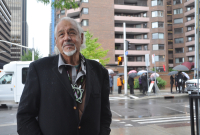Support strong Canadian climate journalism for 2025
Jennifer Lipka stops mid-sentence to swing a bug net over a row of late-season flowers blooming at the University of British Columbia’s campus farm. Inside is a native bumblebee.
"I've been doing this for a while now," explained the UBC master's student and native bee researcher, expertly sliding the insect into a plastic container. "I see a bee and tend to just drop everything … and catch it. Kind of like catching Pokémon."
While she has always been drawn to bees, Lipka has only recently begun catching them for her research into how native bees are impacted by changes in land use, climate change and pollution. Modern industrial farming practices like pesticides can harm native bees, contributing to their global decline. Lipka is looking at these impacts and how to make farms more friendly to native bees.
The stakes are high: without a diversity of pollinators, everything from food security to native plants is in danger.
About three-quarters of the world's crops depend on pollinators. Without them, Oxford University's Our World in Data estimates that overall yields would decrease by about seven per cent — but many fruits, vegetables and oilseed crops like sunflowers would be harder hit.
In North America, most farmers with crops that need pollination rely on a single, imported bee species — the domesticated honeybee — to do most of the work. Every year, they hire itinerant beekeepers to plop hives in their fields or orchards, expecting the honeybees to pollinate the crops.
Sometimes, the honeybees fail. Nearly half of Canada's honeybee colonies didn't survive the past winter, a decline largely attributed to a parasitic mite. Replacing those colonies is expensive and relies on queen bees imported from as far afield as Australia. The vulnerability of these global connections was laid bare in 2020 as beekeepers scrambled to import the queen bees vital to Canada's agricultural industry as international flights came to a standstill.

Native bees are also more effective pollinators, Lipka said. For instance, bumblebees buzz at a specific frequency to shake pollen off some types of blossoms. It's a technique that honeybees can't replicate, making them far less effective than their native cousins, Lipka explained.
Research published earlier this month in the scientific journal Nature found a breadth of native bees is necessary to maintain crop yields over a full growing season or even years. The team looked at native bee populations on farms in two eastern U.S. states and California and found that many different species are needed for pollination across the entire flowering season.
Different bee species pollinated the same type of plants at different times in the growing season, and each species changed which plants they preferred to pollinate from year to year. Natural fluctuations in native bee populations meant ensuring all the bee species survived to maintain a minimum level of pollination in leaner years.
"Biodiversity plays a key role in the stability of ecosystems over time," lead researcher Natalie Lemanski, a postdoctoral researcher at Rutgers University, said in a statement. "You do actually need more bee species in order to get stable pollination services over a growing season and over years."
Protecting bee diversity hasn't been prioritized on most modern industrial farms where monocultures — the common practice of growing vast swaths of a single crop — make it hard for them to nest and feed, Lipka said.
"The way that we've managed land and agriculture is not in a way that supports pollinators."
The UBC farm is an exception. Gesturing towards a nearby coppice, she explained the tall cedars and fir trees were a haven for bumblebees to nest in that was also close enough to the fields for them to feed and pollinate crops. The forests and shrubs scattered around the farm combined with its diversity of crops — everything from tomatoes to amaranth to apples — also appealed to other native bee species.
The situation isn't all bad. At least in B.C., Lipka said some native bee species "are doing really well." But regardless of their conservation status, we should be careful not to overlook the benefits of bee diversity.
"I would never want to be extreme and say, 'All bumblebees, all native bees are in trouble and we have to protect them,’" she said. "But we (should) want to protect them, even if they're doing really well."






Comments